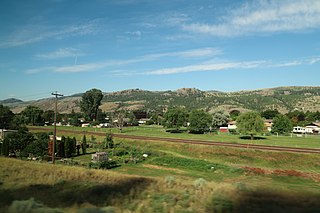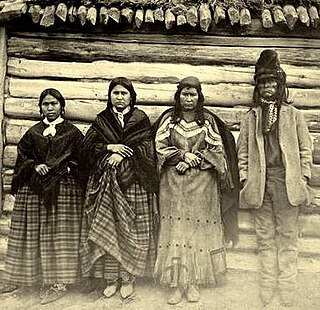| Devick Lake | |
|---|---|
| Coordinates | 50°54′13″N120°04′53″W / 50.90361°N 120.08139°W |
Devick Lake is a lake near Heffley Creek, British Columbia.
| Devick Lake | |
|---|---|
| Coordinates | 50°54′13″N120°04′53″W / 50.90361°N 120.08139°W |
Devick Lake is a lake near Heffley Creek, British Columbia.
It is named for Henri Louis Devick who came from Switzerland in 1904 to settle west of Heffley Creek, British Columbia. It is the source of Devick Creek. [1]
Highway 5 is a 543 km (337 mi) north–south route in southern British Columbia, Canada. Highway 5 connects the southern Trans-Canada route with the northern Trans-Canada/Yellowhead route, providing the shortest land connection between Vancouver and Edmonton. Despite the entire route being signed as part of the Yellowhead Highway, the portion of Highway 5 south of Kamloops is also known as the Coquihalla Highway, while the northern portion is known as the Southern Yellowhead Highway. The Coquihalla section was a toll road until 2008.

The Peace River is a 1,923-kilometre-long (1,195 mi) river in Canada that originates in the Rocky Mountains of northern British Columbia and flows to the northeast through northern Alberta. The Peace River joins the Athabasca River in the Peace-Athabasca Delta to form the Slave River, a tributary of the Mackenzie River. The Finlay River, the main headwater of the Peace River, is regarded as the ultimate source of the Mackenzie River. The combined Finlay–Peace–Slave–Mackenzie river system is the 13th longest river system in the world.

The Thompson–Nicola Regional District is a regional district in the Canadian province of British Columbia. The Canada 2021 Census population was 143,680 and the area covers 44,449.49 square kilometres. The administrative offices are in the main population centre of Kamloops, which accounts for 78 percent of the regional district's population. The only other city is Merritt; other municipally-incorporated communities include the District Municipalities of Logan Lake, Barriere and Clearwater and the Villages of Chase, Ashcroft, Cache Creek, Clinton and Lytton, and also the Mountain Resort Municipality of Sun Peaks.

Williston Lake is a reservoir created by the W. A. C. Bennett Dam which is located in the Northern Interior of British Columbia, Canada.

Diana Lake Provincial Park is a 233 hectares provincial park located 16 kilometres east of the city of Prince Rupert in the North Coast Regional District of British Columbia, Canada. The park was established by BC Parks in 1980.
Kootenay Lake Provincial Park is a provincial park in British Columbia, Canada. It encompasses five widely dispersed parks around Kootenay Lake: Kootenay Lake Provincial Park, Kootenay Lake Provincial Park, Kootenay Lake Provincial Park, Kootenay Lake Provincial Park, and Kootenay Lake Provincial Park.
Kikomun Creek Provincial Park is a provincial park in British Columbia, Canada.

Heffley Creek is a neighbourhood of Kamloops, British Columbia, Canada along Highway 5. The city's northernmost community, it is bordered by the North Thompson River to the west, Sun Peaks to the east, Rayleigh to the south, and Vinsulla to the north. It contains a general store, community hall and elementary school. Along with the Rayleigh neighborhood, it is physically separated from the rest of Kamloops by the Thompson River and by the Kamloops Indian Reserve; Heffley Creek is located within the limits of the City of Kamloops.
North Thompson Oxbows Jensen Island Provincial Park is a provincial park in Thompson-Nicola Regional District in the Interior region of British Columbia, Canada, about 20 kilometres (12 mi) north of Kamloops at the community of Heffley Creek. The park was established on April 30, 1996, and has an area of 30 hectares. It protects the riparian habitat of a single, seasonal oxbow on the right bank of the North Thompson River. There are no camping or day-use facilities.

Paul Lake Provincial Park is a provincial park in British Columbia, Canada, located southwest of Heffley Lake and to the northeast of the city of Kamloops.
Knouff Lake is a lake located 45 km (28 mi) north of Kamloops at an elevation of 1,149 metres. Access is off the Yellowhead Highway via the Heffley Creek Road, or alternatively via Vinsulla off the Yellowhead Highway, which is located approx 5 km further past Heffley Creek Road. It is a medium sized lake with a large population of moderate to large rainbow trout which are often fished using caddisfly as bait. Knouff Lake is serviced with hydro, phone, year round maintained roads and school bus pickup.
Cahilty Lake is a lake in British Columbia, Canada.
School District 73 Kamloops/Thompson a school district based in Kamloops, British Columbia, Canada.
The Whispering Pines/Clinton Indian Band, also called the Pellt'iq't First Nation is a member of the Secwepemc (Shuswap) Nation, located in the Central Interior region of the Canadian province of British Columbia. Its main Indian reserve is located at Clinton, British Columbia. It was created when the government of the then-Colony of British Columbia established an Indian reserve system in the 1860s. It is a member government of the Shuswap Nation Tribal Council.

Rayleigh is a neighbourhood of Kamloops, British Columbia, Canada along Highway 5. It is located on the east side of the North Thompson River and south of the community of Heffley Creek.

Kamloops Transit operates the public bus transit system in the City of Kamloops in south central British Columbia, Canada. The system consists of 18 regularly scheduled routes, one Sunday route, several school specials and handyDART customized service for those with a disability. Funding is provided through a partnership between the City of Kamloops and BC Transit, the provincial agency which plans and manages municipal transit systems. Operations are contracted out to FirstCanada ULC. The transit system began development in 1975 after the Province of British Columbia began offering subsidies to help operate local transit systems in local communities.

Jean Baptiste Lolo also known as St. Paul or Chief St. Paul, or Chief Lolo, was an employee and interpreter with the Hudson's Bay Company in pre-Confederation British Columbia, Canada. Son of Chief Michael Okanese 'Little Bone' Cardinal. First serving in the region at Fort Fraser in the New Caledonia fur district, he acquired the nickname there of St. Paul because of his affection for that saint. He was the right-hand man of John Tod and followed him to Fort Kamloops, where Tod was Chief Trader from 1841 to 1843, and remained in that region for the rest of his life. He acquired such great respect among the local Secwepemc (Shuswap) people as to become regarded as a chief.
"His face was a very fine one, although sickness and pain had worn it away terribly. His eyes were black, piercing and restless; his cheekbones high, and the lips, naturally thin and close, had that white, compressed look which tells so surely of constant suffering."
When Mayne remarked that Lolo, in his decayed health, must find it hard to rule over his people,
"... he heard me with a grim smile, and for answer turned back his pillow, where a loaded gun and a naked sword lay ready to his hand."
The invalid Lolo showed, in fact, unexpected reserves of strength. Rising from his bed, he mounted his horse, and accompanied Mayne on a ride to see the view from the top of a neighbouring mountain, which was forthwith named Mt. St. Paul in honour of the old chief. Moreover, Lolo insisted on accompanying Mayne on the next lap of his journey, that from Kamloops to Pavilion."